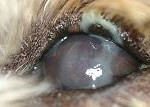News
Archive for December, 2014
DRY EYE OFFER
by on December 3rd, 2014
Category: Special Offers, Tags:
Pet of the Month – December 2014
by on December 3rd, 2014
Category: Pet of the Month, Tags:
 Niamh is a lovely Springer/Labrador cross with great owners. She presented in the summer with a history of vomiting and diarrhoea after possible ingestion of rhubarb.
Niamh is a lovely Springer/Labrador cross with great owners. She presented in the summer with a history of vomiting and diarrhoea after possible ingestion of rhubarb.
Dry Eye
by on December 3rd, 2014
Category: News, Tags:
Keratoconjunctivitis sicca (KCS), commonly referred to as “Dry Eye”, is one of the most common dog eye problems. Dry Eye affects 1 in every 22 dogs.
Dry Eye is caused by destruction of the tear glands by the dog’s immune system. This means that too few natural tears are produced. Damage to the tear glands is irreversible. If left untreated, eventually the tear glands are completely destroyed and the dog loses the ability to produce tears. Dry Eye is a painful condition, and ultimately leads to permanent blindness.
Natural tears have many important functions which are lost in Dry Eye: they carry vital nutrients and oxygen, lubricate and cleanse the eye, and help protect against infection. Without tears, the eye becomes very dry and uncomfortable. Conjunctivitis, eye infections and ulcers become more common and discharge may be seen from the eyes. New blood vessels start to grow on the surface of the eye and dark pigmentation may develop. Eventually these changes lead to permanent blindness. It is very important to diagnose Dry Eye early, before these undesirable changes become severe and much of the tear tissue is destroyed.
It is important to recognize that in the vast majority of cases, Dry Eye is a lifelong condition and requires lifelong treatment. If not treated correctly, the dog will experience discomfort and the disease will affect its sight and welfare long term.
Dry Eye has a very variable appearance, so it is not possible to diagnose the condition just by looking at it. Fortunately there is a quick and simple test to diagnose Dry Eye, and with correct treatment the condition can be managed successfully long term.
Dry eye can affect all breeds at any age, so it is important to be aware of the signs to look out for.
Signs of Dry Eye
The appearance of Dry Eye can be quite varied and subtle, especially early in the disease. It is better for the health of the dog’s eyes to pick up the problem early, so that more tear tissue remains and fewer abnormal changes to the eyes develop. The earlier the problem is diagnosed and treated, the better the long term outlook for the dog’s eyes.
We recommend testing virtually all sore eyes for Dry Eye, to make sure the condition is diagnosed as early as possible.
If your dog has any of the following signs, you should make an appointment with your veterinarian. Remember to tell your veterinarian if your dog has experienced any previous eye problems.
Signs to look out for
- Uncomfortable eyes – your dog may blink excessively, rub its eyes or try to keep its eyes closed
- Eyes red and inflamed
- Discharge from the eyes
- Dry looking eyes
- Frequent conjunctivitis, eye infections or corneal ulcers
- Dark pigment on the surface of the eyes
- Prominent blood vessels on the surface of the eyes
As dogs with Dry Eye are prone to getting eye infections and conjunctivitis, we recommend testing for Dry Eye in all dogs that have had more than one eye infection in any 12-month period. Otherwise, Dry Eye could be missed and the dog only treated for the infection, and not the ongoing underlying problem.
Diagnosing Dry Eye
Diagnosis of Dry Eye is quick and simple – the test only takes 60 seconds. Your veterinarian probably already tests most dogs with eye problems as well as predisposed breeds routinely.
Your veterinarian measures tear production in dogs using a Schirmer tear test (STT). The STT involves placing a special strip of paper in the eye to assess tear production. Usually the tear production in both eyes is tested as the results are often quite different. The test will not cause your dog any discomfort and does not require sedation or anesthesia. The results of this test are available are immediately. The results of the test are interpreted along with other findings, such as clinical signs, to determine whether KCS is present. If your dog has Dry Eye, it is not producing sufficient tears and should be started on treatment immediately.
Breeds affected by Dry Eye
Dry Eye is very common – 1 in every 22 dogs are affected by this disease. However, in certain breeds, this figure is almost doubled. It is important to be aware that the eyes of some dogs affected by Dry Eye look quite normal, despite severely reduced tear production and destruction of the tear glands. The sooner Dry Eye is diagnosed and the correct treatment started, the better the long term outlook for the dog’s eyes. Dry Eye is also painful (a bit like having grit in your eyes) so prompt treatment will also improve the welfare of the dog.
Predisposed Breeds
All breeds of dogs can develop Dry Eye at any age, but some are more prone to the condition. Breeds of dog particularly susceptible to Dry Eye include:
English Cocker spaniel
West Highland White terrier
Cavalier King Charles spaniel
Shih-Tzu
Other breeds include the Yorkshire terrier, Bulldog, Pekingese, Pug and Lhasa Apso.
We recommend testing susceptible breeds regularly and many owners elect to have their dog tested during a routine appointment, such as for vaccination. This ensures that Dry Eye is picked up early and treatment started before too much tear gland tissue is destroyed.
Diagnosis of Dry Eye is quick and simple – the test only takes 60 seconds and involves placing a special strip of paper in the eye to assess tear production.
Call us today to make an appointment.


